Readings Newsletter
Become a Readings Member to make your shopping experience even easier.
Sign in or sign up for free!
You’re not far away from qualifying for FREE standard shipping within Australia
You’ve qualified for FREE standard shipping within Australia
The cart is loading…






Multivariate categorical outcomes, such as Likert scale responses and disease diagnoses, require specialized structural equation modeling (SEM) software to be analyzed properly. Providing needed skills for applied researchers and graduate students, this book leads readers from regression analysis with categorical outcomes to complex SEMs with latent variables for categorical indicators. The initial section sets the stage by demonstrating regression analyses for binary, ordered, or count outcomes using R, with comparable SAS code at the companion website. Chapters then reanalyze the same data using Mplus and R lavaan to show how univariate models for categorical outcomes can be estimated and interpreted with SEM programs. Subsequently, the book turns to multivariate models, discussing path models, confirmatory factor models, and latent variable path models with categorical outcomes. Concluding chapters cover advanced SEM with categorical outcomes, including growth models, latent class models, and survival models. Worked-through examples and annotated Mplus and lavaan code are featured throughout.
$9.00 standard shipping within Australia
FREE standard shipping within Australia for orders over $100.00
Express & International shipping calculated at checkout
Multivariate categorical outcomes, such as Likert scale responses and disease diagnoses, require specialized structural equation modeling (SEM) software to be analyzed properly. Providing needed skills for applied researchers and graduate students, this book leads readers from regression analysis with categorical outcomes to complex SEMs with latent variables for categorical indicators. The initial section sets the stage by demonstrating regression analyses for binary, ordered, or count outcomes using R, with comparable SAS code at the companion website. Chapters then reanalyze the same data using Mplus and R lavaan to show how univariate models for categorical outcomes can be estimated and interpreted with SEM programs. Subsequently, the book turns to multivariate models, discussing path models, confirmatory factor models, and latent variable path models with categorical outcomes. Concluding chapters cover advanced SEM with categorical outcomes, including growth models, latent class models, and survival models. Worked-through examples and annotated Mplus and lavaan code are featured throughout.